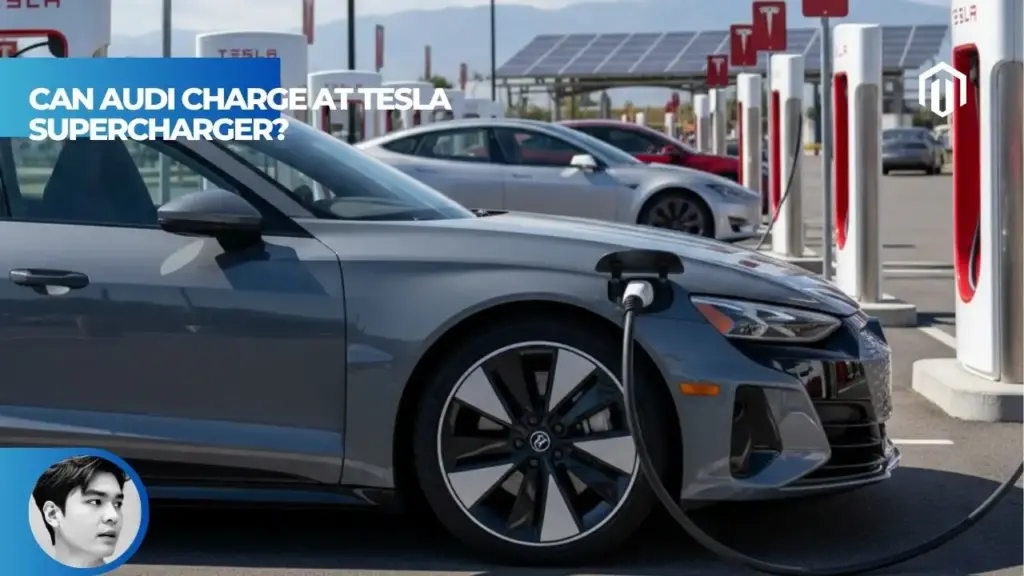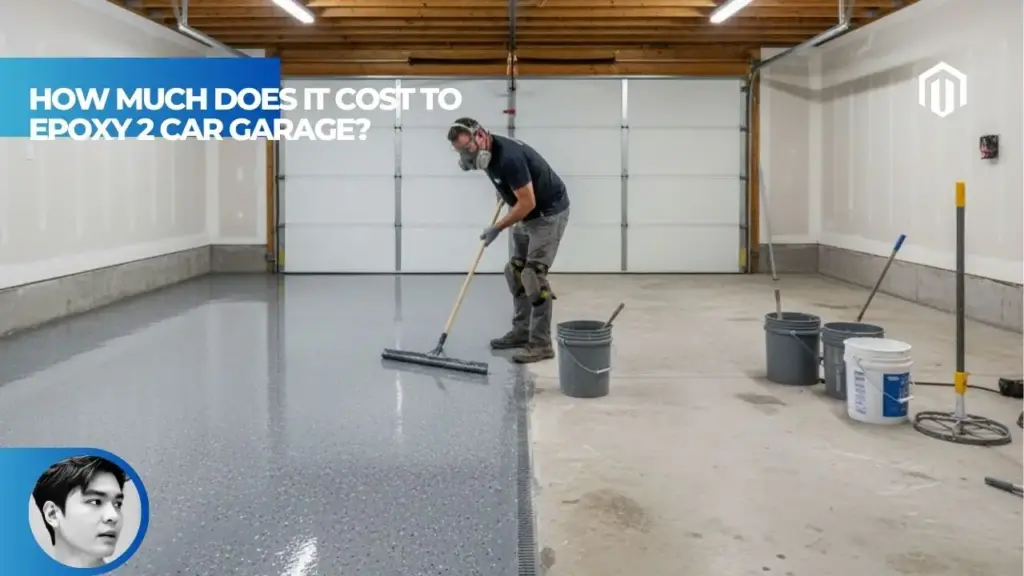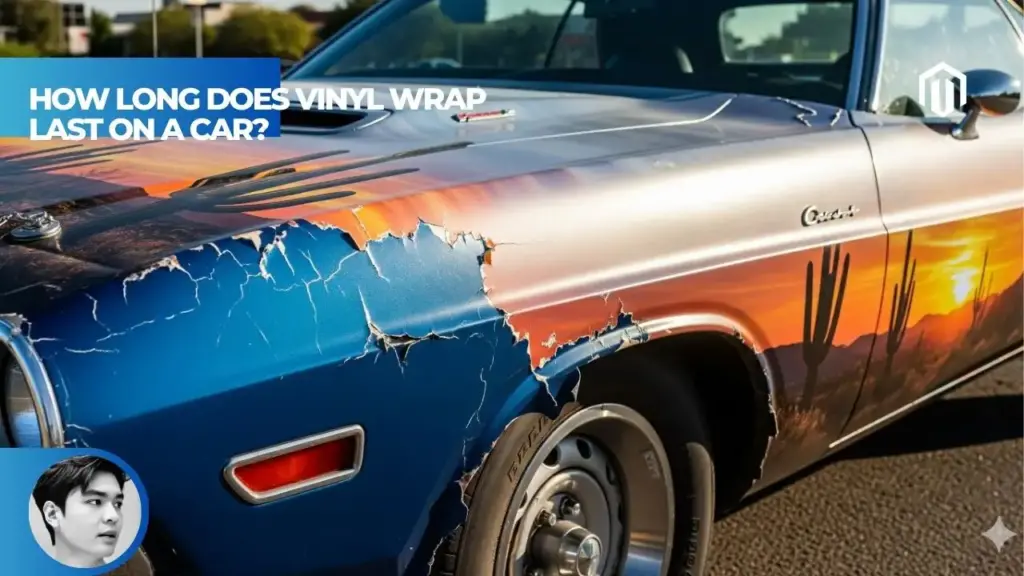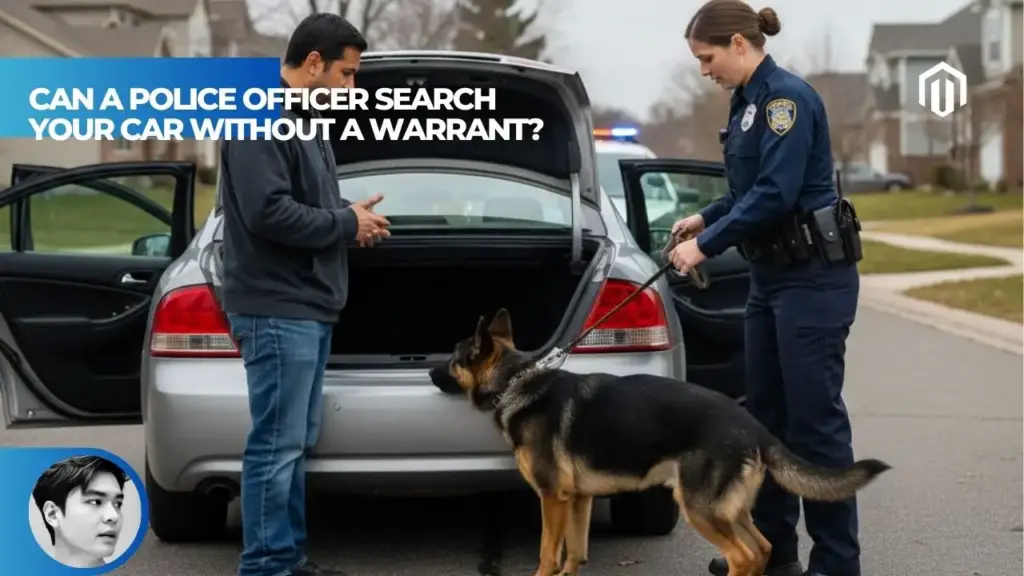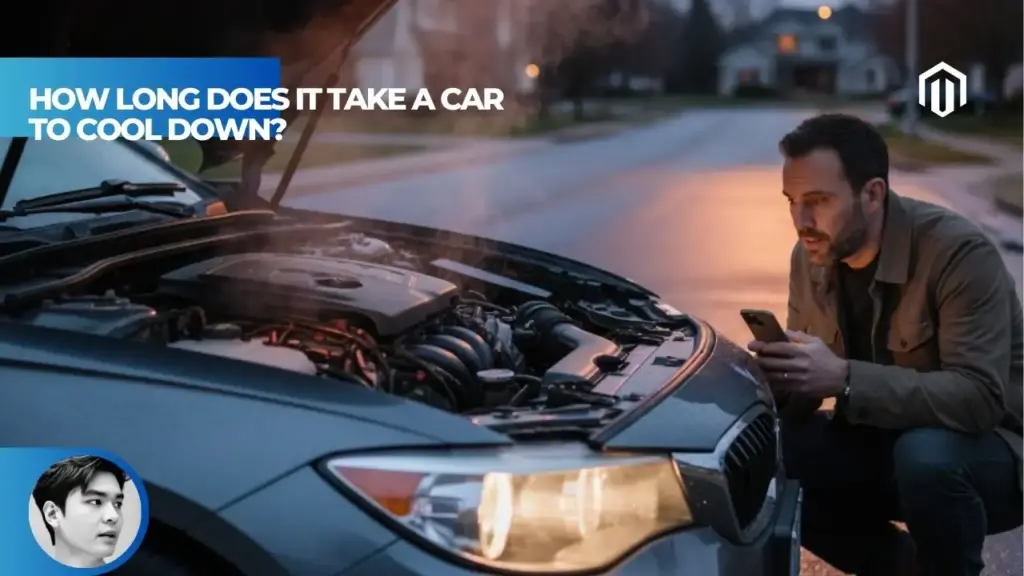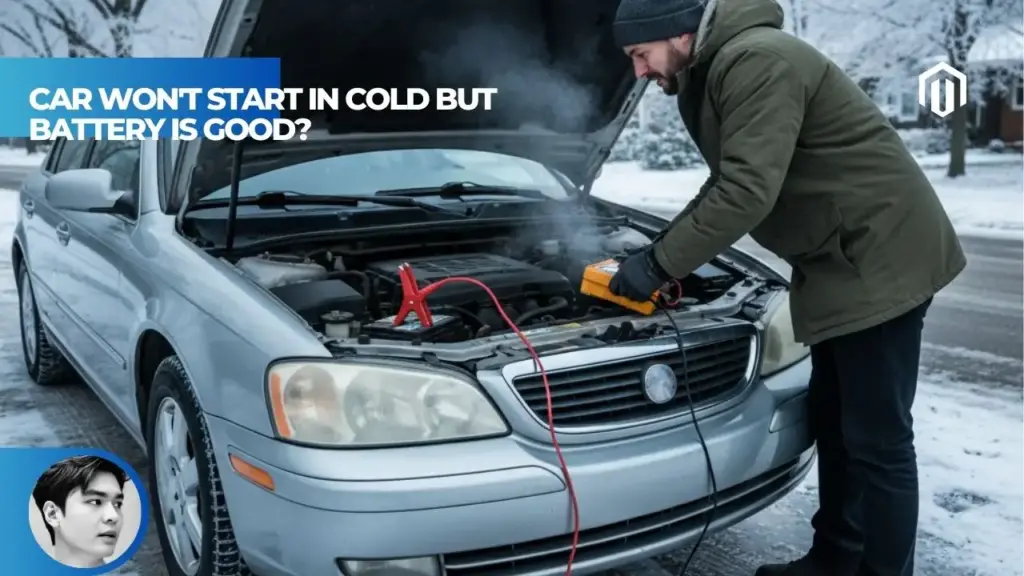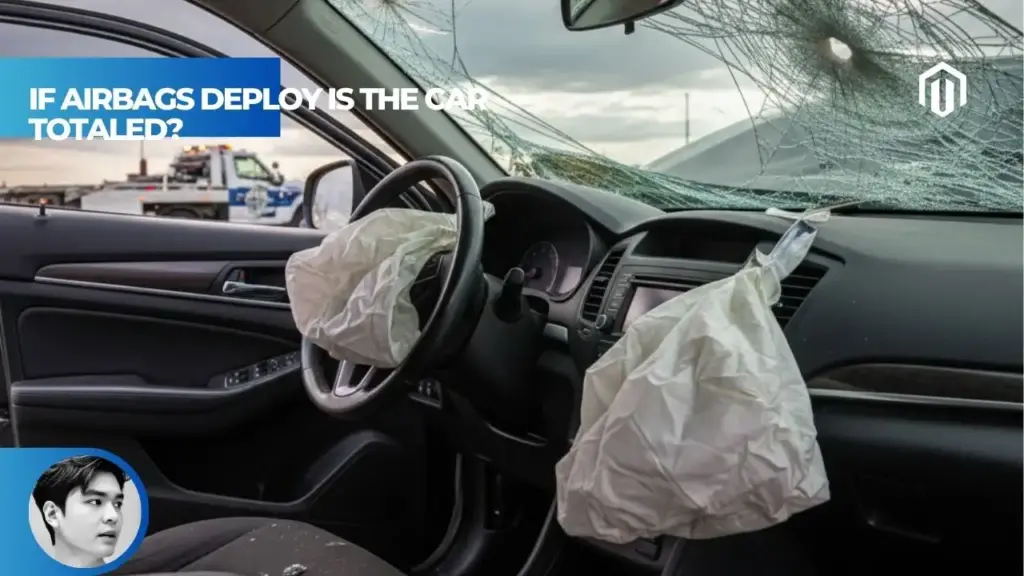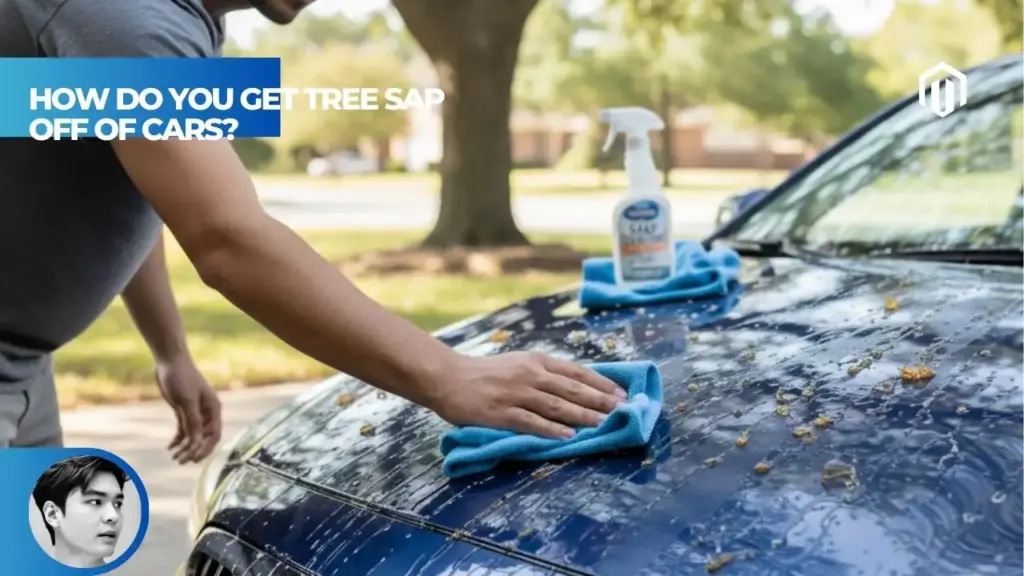You may also like:
- 【Guide】Audi Electrify America Free Charging: (A Full Guide)
- 【Explained】Can BMW Charge at Tesla Supercharger? The NACS Adoption Timeline Explained
- 【Explained】Who Makes Audi Cars? Inside the Volkswagen Group Structure
- 【2025】Top 8 Best Audi SUVs for Families & Daily Driving
- 【2025】Top 7 Best Audi Sports Cars Ranked
Yes, select Audi e-tron models can charge at Tesla Superchargers starting September 2025, but they require a manufacturer-approved NACS to CCS adapter and must use the Tesla app for payment and session initiation. The Q6 e-tron, A6 Sportback e-tron, and e-tron GT are the first compatible models, giving drivers access to over 23,500 Tesla Supercharger stalls nationwide.
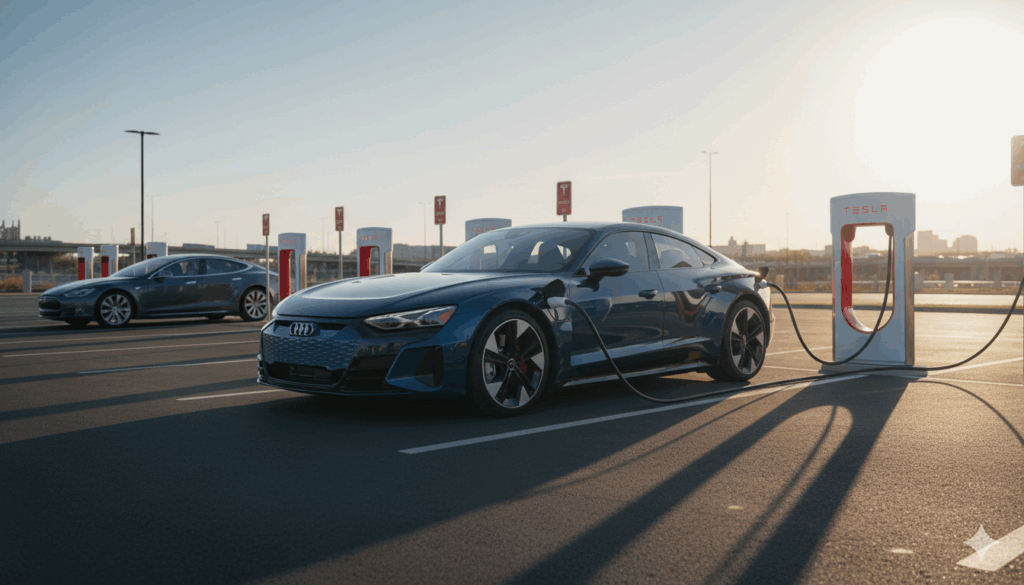
Audi e-tron Tesla Supercharger Access Overview
The automotive charging landscape shifted dramatically in September 2025 when Audi announced Tesla Supercharger access for select e-tron models. This development represents a major expansion of charging infrastructure for Audi EV owners, effectively doubling their fast-charging options across North America.
According to Autvex charging experts, this integration marks one of the most significant improvements in EV charging convenience since the introduction of universal charging standards. The partnership between Volkswagen Group and Tesla creates unprecedented charging flexibility for premium EV owners.
Charge Audi at Tesla Network Availability Timeline
Starting September 9, 2025, Audi began rolling out Tesla Supercharger access to select e-tron models[1]. The phased approach ensures proper testing and compatibility verification before widespread deployment.
Initial rollout timeline:
- September 9, 2025: Soft launch for Q6, A6, and e-tron GT
- Late September 2025: Full integration begins
- Q4 2025: myAudi app integration expected
- 2026: Additional model compatibility announcements
The gradual expansion allows Audi to monitor performance and address any technical issues before broader implementation. This careful approach mirrors Audi’s partnership with Electrify America, which established their initial charging network foundation.
North American Charging Standard (NACS) for Audi Explained
NACS represents Tesla’s charging connector design, now adopted as an industry standard across North America[2]. This standardization simplifies charging infrastructure and reduces the need for multiple connector types.
NACS advantages for Audi owners:
- Access to 23,500+ Tesla Supercharger stalls
- Smaller, lighter connector design
- Higher power delivery capability (up to 1000V)
- Proven reliability across millions of charging sessions
- Future-proof technology adoption
The transition to NACS doesn’t eliminate CCS charging. Audi vehicles maintain their CCS ports, using adapters to bridge the connection gap, similar to how universal EV chargers accommodate multiple standards.
Volkswagen Group Tesla Supercharger Deal Details
Volkswagen Group’s agreement with Tesla encompasses multiple brands, including Audi, Porsche, and future Scout models[3]. This comprehensive deal represents billions in infrastructure value suddenly available to VW Group customers.
Key agreement components:
- Access to Tesla’s entire Supercharger network
- Development of certified adapters for existing vehicles
- Future native NACS port integration (timeline pending)
- Shared charging data and network optimization
- Continued Electrify America partnership maintenance
The deal maintains Electrify America as a core charging partner while expanding options significantly for Audi drivers planning longer trips.
NACS to CCS Adapter Audi Requirements
Understanding adapter requirements ensures safe, reliable charging at Tesla Superchargers. Audi’s strict specifications protect both vehicles and charging infrastructure.
Do You Need an Adapter to Charge an Audi at a Tesla Supercharger?
Yes, all current Audi e-tron models require a NACS to CCS adapter for Tesla Supercharger compatibility[1]. This adapter bridges the physical and communication differences between charging standards.
Adapter necessity reasons:
- Current Audis use CCS (Combined Charging System) ports
- Tesla Superchargers use NACS connectors
- Communication protocols differ between systems
- Voltage and amperage negotiations require translation
- Safety interlocks must function properly
The adapter isn’t just a physical connector—it’s an intelligent interface managing complex electrical and data exchanges between incompatible systems.
Audi Supercharger Compatibility Update for 2025
New 2025 Audi e-tron models arriving from port include factory-installed adapters[4]. This integration streamlines the ownership experience for new buyers while existing owners await adapter availability.
2025 compatibility status:
| Model | Adapter Included | Compatibility Status |
|---|---|---|
| Q6 e-tron | Yes (Sept 2025+) | Fully Compatible |
| A6 Sportback e-tron | Yes (Sept 2025+) | Fully Compatible |
| e-tron GT | Yes (Sept 2025+) | Fully Compatible |
| Q4 e-tron | No | Not Currently Compatible |
| Q8 e-tron | Pending | Future Announcement |
| Older e-tron models | Available Later | Pending Availability |
Compatibility testing ensures safe operation across temperature extremes and charging conditions typical of North American driving.
Third-Party NACS Adapters for Audi Safety Concerns
Audi explicitly prohibits third-party adapters, citing safety and warranty concerns[1]. Only manufacturer-approved adapters guarantee proper function and protection.
Risks of unauthorized adapters:
- Potential overheating and fire hazards
- Incorrect voltage/amperage delivery
- Communication protocol failures
- Warranty voiding for charging-related damage
- Insurance claim denial possibilities
- Permanent battery management system damage
Autvex strongly recommends waiting for official Audi adapters rather than risking vehicle damage with untested alternatives. The cost savings aren’t worth potential five-figure repair bills.
Which Audi e-tron Models Can Use Tesla Supercharger
Model compatibility varies based on technical specifications and testing completion. Understanding which vehicles qualify helps owners plan their charging strategy.
Compatible Audi Models Starting September 2025
Three Audi models gained immediate Tesla Supercharger access in September 2025[1]. These vehicles underwent extensive testing to ensure safe, reliable charging performance.
Currently compatible models:
- 2025 Audi Q6 e-tron: Full compatibility with adapter
- 2025 Audi A6 Sportback e-tron: Full compatibility with adapter
- 2025 Audi e-tron GT: Full compatibility with adapter
These models represent Audi’s latest Premium Platform Electric (PPE) architecture, designed with enhanced charging capabilities. Their 800-volt systems maximize charging speeds at compatible stations.
Audi CCS Charging at Supercharger Specifications
Technical specifications determine charging performance at Tesla Superchargers[5]. Understanding these limits helps set realistic expectations for charging sessions.
Charging specifications:
| Parameter | Specification | Notes |
|---|---|---|
| Max Power | 250 kW | Limited by Supercharger V3 |
| Voltage Range | 400-1000V | PPE models use 800V |
| Current Limit | 625A | NACS connector maximum |
| Charging Curve | Variable | Optimized by BMS |
| Session Time | 10-45 minutes | 10-80% typical |
Real-world charging speeds depend on battery temperature, state of charge, and station availability. Peak rates typically occur between 10-40% battery capacity.
Q4 e-tron Compatibility Status
The Audi Q4 e-tron remains incompatible with Tesla Superchargers[1]. Technical limitations prevent safe adapter use with this model.
Q4 e-tron exclusion reasons:
- Different electrical architecture (MEB platform)
- Lower voltage system (400V maximum)
- Communication protocol incompatibility
- Charging port location challenges
- Cost-benefit analysis for adapter development
Q4 e-tron owners must continue relying on CCS networks like Electrify America. Future compatibility updates remain possible but unconfirmed, similar to how certain features vary by model year.
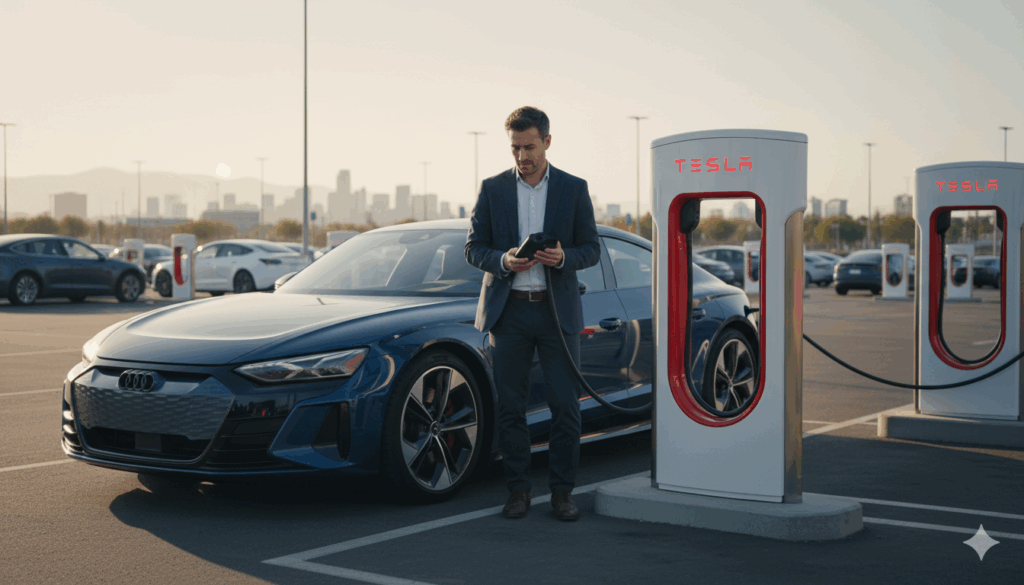
Tesla App and MyAudi App Tesla Integration
Software integration proves as crucial as hardware compatibility for seamless charging experiences. Current limitations require workarounds that will improve over time.
Do I Have to Use the Tesla App to Charge My Audi?
Yes, initially all Audi owners must use the Tesla app for Supercharger sessions[6]. This temporary requirement will change as integration develops.
Tesla app requirements:
- Download and create Tesla account
- Add payment method (credit/debit card)
- Enable location services
- Select “Charge Your Non-Tesla”
- Choose specific Supercharger stall
- Initiate and monitor charging session
The process adds steps compared to Electrify America’s plug-and-charge convenience but provides access to significantly more charging locations.
MyAudi App Tesla Integration Future Updates
Full myAudi app integration is expected by Q4 2025, eliminating the need for Tesla’s app[6]. This update will streamline the charging process significantly.
Planned myAudi enhancements:
- Native Supercharger location display
- Integrated payment processing
- Single-app charging management
- Real-time availability updates
- Trip planning with mixed networks
- Charging history consolidation
The integration parallels features already available for Audi navigation systems, creating unified user experiences.
Payment and Session Initiation Process
Current payment requires Tesla app processing, but future updates will enable seamless transactions[4]. Understanding the process minimizes charging delays.
Step-by-step charging process:
- Park at compatible Supercharger stall
- Connect NACS adapter to vehicle first
- Attach Supercharger cable to adapter
- Open Tesla app on smartphone
- Select charging location and stall number
- Confirm vehicle and initiate session
- Monitor charging progress in app
- Stop session when complete
- Disconnect in reverse order
Payment processes automatically through stored credentials. Rates vary by location and time but typically range from $0.25-0.50 per kWh.
Audi EV Charging Infrastructure Options
Beyond Tesla Superchargers, Audi owners enjoy access to extensive charging networks. Understanding all options ensures optimal route planning and cost management.
Audi EV Charging Options Beyond Tesla
Audi e-tron vehicles access multiple charging networks through various partnerships[7]. This redundancy ensures charging availability even in remote areas.
Available charging networks:
- Electrify America: 5,000+ stations, free charging packages
- ChargePoint: 35,000+ Level 2 locations
- EVgo: 2,000+ fast charging stations
- IONITY (limited US presence): Premium European network
- Local utilities: Regional networks with member benefits
Combined with Tesla access, Audi drivers can use over 28,000 DC fast charging ports nationwide, rivaling Tesla’s own network coverage.
Electric Vehicle Charging Standards (NACS, CCS) Comparison
Understanding charging standards helps optimize charging strategies across different networks[2]. Each standard offers unique advantages.
| Standard | Connector Type | Max Power | Adoption | Advantages |
|---|---|---|---|---|
| NACS | Tesla design | 1MW potential | Growing rapidly | Compact, reliable |
| CCS | Combined AC/DC | 350kW current | Industry standard | Universal compatibility |
| CHAdeMO | Japanese design | 400kW | Declining | Bidirectional capable |
| J1772 | AC Level 2 | 19.2kW | Universal AC | Home charging standard |
Most public stations now support multiple standards through various connectors or adapters, ensuring broad compatibility.
Audi EV Road Trips Planning with Expanded Network
Tesla Supercharger access transforms road trip planning for Audi owners[7]. The expanded network eliminates many previous routing constraints.
Road trip planning improvements:
- 60% more charging options on major routes
- Reduced detours for charging stops
- Better rural and interstate coverage
- Redundant charging options at popular destinations
- Shorter wait times with more stalls available
Planning tools like A Better Route Planner (ABRP) already incorporate Tesla Supercharger access for compatible Audi models, optimizing routes automatically.
Adapter Functionality and Limitations
Understanding adapter capabilities prevents frustration and ensures safe operation. Clear limitations exist that owners must recognize.
Does the Adapter Work with Level 1 and Level 2 AC Chargers?
No, the Audi NACS adapter only works with DC fast charging[1]. This limitation excludes many charging scenarios owners might expect.
Adapter limitations:
- Not compatible: Tesla Wall Connectors
- Not compatible: Tesla Destination Chargers
- Not compatible: Tesla Mobile Connectors
- Not compatible: Any AC charging equipment
- Only compatible: DC Fast Charging Superchargers
This restriction means home charging still requires CCS-compatible equipment, maintaining existing installation requirements for residential users considering cross-shopping other EVs.
DC Fast Charging Exclusivity
The adapter’s DC-only design reflects technical requirements for safe high-power charging[5]. AC and DC charging involve fundamentally different electrical processes.
Technical reasons for DC exclusivity:
- Different communication protocols between AC/DC
- Onboard charger bypass for DC charging
- Higher voltage/current handling requirements
- Thermal management considerations
- Safety interlock differences
- Cost and complexity of dual-standard support
DC fast charging delivers power directly to the battery, bypassing onboard conversion systems entirely different from AC charging paths.
Tesla Destination Charger Incompatibility
Tesla Destination Chargers remain incompatible despite using NACS connectors[1]. This limitation surprises many owners expecting universal NACS compatibility.
Destination Charger characteristics:
- Level 2 AC charging (up to 11.5kW)
- Found at hotels, restaurants, shopping centers
- Free or low-cost charging
- 4-8 hours for full charge
- No adapter solution available
- CCS alternatives usually nearby
Audi owners must seek alternative Level 2 charging at these locations, typically finding J1772 stations at the same venues.
Finding Compatible Tesla Superchargers for Audi
Locating appropriate charging stations requires understanding compatibility markers and navigation tools. Not all Tesla stations work with partner vehicles.
Where Can I Find Compatible Tesla Superchargers for My Audi?
Compatible stations appear in multiple navigation platforms, simplifying discovery[6]. Proper identification prevents arriving at incompatible locations.
Finding compatible chargers:
- Tesla app: Shows “NACS Partner Sites”
- myAudi app: Integration pending late 2025
- In-car MMI: Updated maps show locations
- Third-party apps: ABRP, PlugShare, ChargeHub
- Tesla website: Supercharger map with filters
Currently, approximately 80% of Supercharger locations support non-Tesla vehicles, with expansion continuing monthly.
NACS Partner Sites Identification
“NACS Partner Sites” designation indicates compatibility with non-Tesla vehicles[4]. This labeling prevents confusion at charging locations.
Identifying compatible sites:
- Green checkmark in Tesla app
- “Open to Other EVs” notation
- V3 or V4 Supercharger hardware
- Multiple stall availability
- Urban and highway locations
Incompatible sites typically include older V1/V2 Superchargers and capacity-constrained locations reserved for Tesla vehicles.
Navigation Integration Features
Navigation systems increasingly integrate mixed-network routing, optimizing trips across all available chargers[6]. This intelligence minimizes charging time and cost.
Current navigation capabilities:
- Real-time availability updates
- Automatic route optimization
- Preconditioning battery for arrival
- Cost comparison across networks
- Wait time predictions
- Alternative station suggestions
Future updates will add predictive routing based on historical usage patterns and dynamic pricing, similar to connected services already available.
Third-Party Adapter Safety and Warranty
Safety considerations extend beyond immediate functionality to long-term reliability and warranty protection. Official adapters provide essential safeguards.
Are Third-Party NACS Adapters Safe to Use?
Audi strongly prohibits third-party adapter use, citing multiple safety concerns[8]. Unauthorized adapters pose serious risks to vehicle and user safety.
Third-party adapter risks:
- Overheating during high-power charging
- Incorrect pin mapping causing shorts
- Inadequate cable gauge for current loads
- Missing temperature monitoring
- Improper ground fault protection
- Communication protocol errors
Reported incidents include melted connectors, damaged charge ports, and battery management system failures requiring expensive repairs not covered under warranty.
UL2252 Certification Importance
UL2252 certification ensures adapter safety through rigorous testing[8]. This standard specifically addresses EV charging equipment safety.
UL2252 testing requirements:
- Temperature rise limits under load
- Mechanical endurance (10,000+ cycles)
- Environmental resistance (water, dust, impact)
- Electrical safety (insulation, grounding)
- Communication protocol verification
- Electromagnetic compatibility
Only Audi’s official adapter meets these stringent requirements, protecting both vehicle and user during every charging session.
Warranty Implications of Unauthorized Adapters
Using non-approved adapters voids warranty coverage for charging-related damage[8]. This risk extends beyond immediate adapter failure.
Warranty violation consequences:
- Denied claims for charge port repairs
- Battery damage exclusions
- Electrical system coverage cancellation
- Potential full warranty voidance
- Insurance claim complications
- Diminished resale value
The potential costs far exceed any savings from cheaper third-party adapters. Autvex recommends patience while awaiting official adapter availability rather than risking extensive repair bills comparable to major service costs.
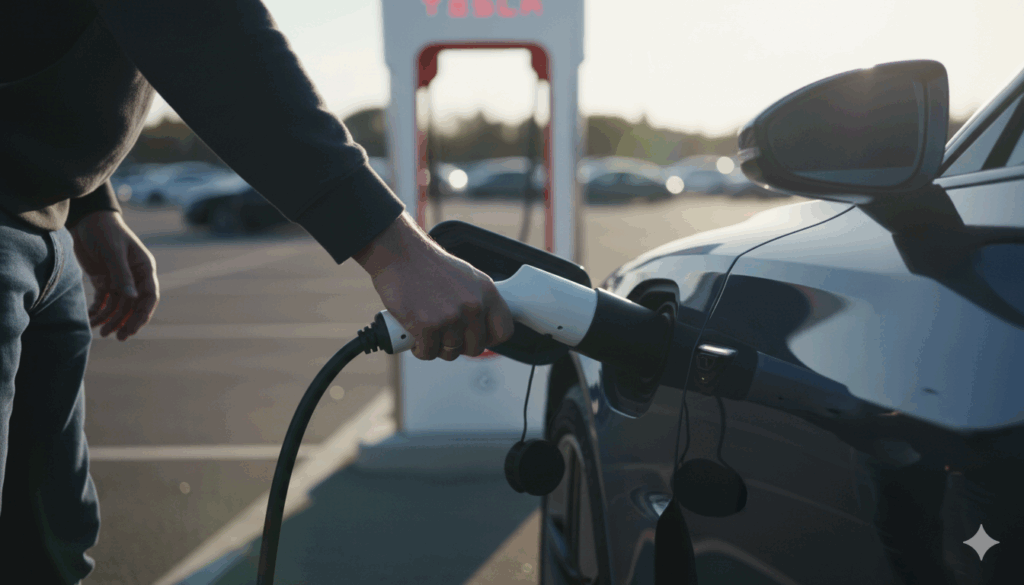
Key Takeaways
- Select 2025 Audi models can use Tesla Superchargers with manufacturer-approved NACS adapters starting September 2025
- Q6 e-tron, A6 e-tron, and e-tron GT are currently compatible, while Q4 e-tron is excluded
- Tesla app required initially for payment and session initiation, with myAudi integration coming later
- Adapter only works with DC fast charging, not Level 1/2 AC or Destination Chargers
- 23,500+ Supercharger stalls now accessible, doubling Audi’s fast-charging network
- Third-party adapters void warranty and pose safety risks—only use Audi-approved equipment
- Integration continues expanding with more models and features planned throughout 2025-2026
Next Steps
First, verify your Audi model’s compatibility with Tesla Superchargers. If you own a 2025 Q6 e-tron, A6 Sportback e-tron, or e-tron GT arriving after September 2025, your vehicle should include the necessary adapter. For earlier 2025 models or older vehicles, monitor Audi’s official announcements for adapter availability.
Download and set up the Tesla app immediately, even before receiving your adapter. Create an account, add payment information, and familiarize yourself with the interface. This preparation ensures smooth first-time charging experiences when you need them most.
Locate compatible Tesla Superchargers along your regular routes using the Tesla app’s map feature. Look specifically for locations marked as “NACS Partner Sites” or “Open to Other EVs.” Not all Supercharger locations support non-Tesla vehicles yet, so verification prevents wasted trips.
Plan your first Supercharger visit during off-peak hours for a stress-free experience. Weekday mornings typically offer the shortest wait times and most available stalls. Bring your adapter, fully charged phone with the Tesla app, and allow extra time for the initial setup process.
Continue using Electrify America and other CCS networks as your primary charging solution. Tesla Supercharger access supplements rather than replaces existing infrastructure. Many Electrify America stations offer higher charging speeds for PPE-platform Audis, and your included charging credits provide cost advantages.
Stay informed about myAudi app updates that will eventually eliminate the need for Tesla’s app. Subscribe to Audi’s newsletter or check the myAudi app regularly for integration announcements. This future functionality will significantly streamline the charging process.
For Q4 e-tron owners, maintain current charging habits using CCS networks while monitoring compatibility updates. Audi may announce adapter availability for these models in 2026, though nothing is confirmed. Consider this limitation when planning vehicle upgrades or long-distance travel requiring extensive fast-charging access.
Frequently Asked Questions
Do you need an adapter to charge an Audi at a Tesla Supercharger?
Yes, you need a manufacturer-approved NACS to CCS adapter to charge most Audi e-tron models at compatible Tesla Superchargers.
Which Audi e-tron models can use a Tesla Supercharger?
Starting September 2025, new 2025 Q6 e-tron, A6 Sportback e-tron, and e-tron GT models include factory-installed adapters. Q4 e-tron is not currently compatible.
Do I have to use the Tesla app to charge my Audi?
Initially yes. You must use the Tesla app to begin and pay for charging sessions. Future myAudi app integration is expected.
Does the adapter work with Level 1 and Level 2 AC chargers?
No, the Audi NACS adapter only works with Level 3 DC fast charging at Superchargers, not AC chargers or Tesla Destination chargers.
Where can I find compatible Tesla Superchargers for my Audi?
Compatible locations appear in Audi MMI navigation and myAudi app once integrated, marked as “NACS Partner Sites” in Tesla app.
Are third-party NACS adapters safe to use?
Audi prohibits third-party adapters and offers its own UL2252 certified NACS DC Charging Adapter for safety and warranty protection.
References
- Audi USA. (2025). Audi announces availability of NACS DC charging adapter and Tesla Supercharger access. Retrieved from https://media.audiusa.com/releases/643
- Tesla. (2025). North American Charging Standard (NACS) adoption and specifications. Retrieved from https://www.tesla.com/NACS
- Volkswagen Group. (2024). Future Volkswagen, Audi, Porsche and Scout electric vehicles gain Tesla Supercharger access. Retrieved from https://media.vw.com/releases/1774
- Audi Cape Fear. (2025). Audi EV Drivers Meet the Tesla Supercharger Network. Retrieved from https://www.audicapefear.com/en/e-tron-tesla-adaptor/tesla-adaptor-announcement/
- Electrive. (2025). Audi and Porsche EV drivers gain NACS adapters technical specifications. Retrieved from https://www.electrive.com/2025/09/08/audi-and-porsche-ev-drivers-gain-nacs-adapters/
- MotorTrend. (2025). The Great NACS Migration: Automaker Tesla Charging Compatibility Guide. Retrieved from https://www.motortrend.com/features/tesla-nacs-charging-port-automaker-compatibility
- Drive Tesla Canada. (2025). Porsche and Audi gain access to Tesla’s Supercharger network in North America. Retrieved from https://driveteslacanada.ca/news/porsche-and-audi-gain-access-to-teslas-supercharger-network-in-north-america/
- Audi Club North America. (2025). Audi Expands EV Charging Network with NACS Adapter Safety Guidelines. Retrieved from https://audiclubna.org/audi-expands-size-of-ev-charging-network-with-nacs-adapter-and-tesla-supercharger-access/

I am a senior automotive analyst at Autvex. Expert vehicle evaluations, in-depth reviews, and objective analysis helping readers make informed automotive decisions with years of industry experience.

